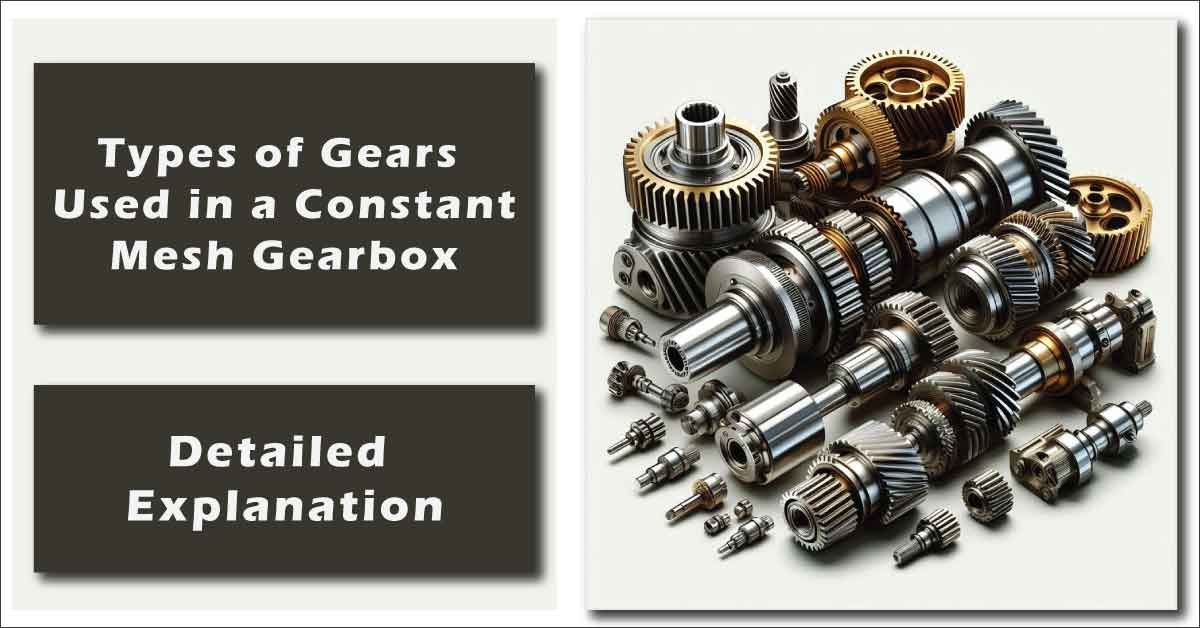Constant mesh gearboxes primarily use helical gears for power transmission. These gears are designed with angled teeth that provide smoother and quieter operation compared to spur gears. The constant engagement of helical gears allows for more efficient power transfer and seamless shifting between gears, making them ideal for high-performance applications.
Which Type of Gears are Used in Constant Mesh Gearbox
A constant mesh gearbox is a sophisticated transmission system used primarily in automotive applications, including motorcycles, trucks, and high-performance vehicles. Unlike traditional sliding mesh gearboxes, constant mesh gearboxes maintain all gears engaged at all times, allowing for smoother and quicker gear changes. This gearbox design utilizes various types of gears to achieve efficient power transfer and optimal performance. Understanding the types of gears employed in a constant mesh gearbox is essential for grasping its functionality and advantages.
Overview of Gear Types in Constant Mesh Gearboxes
In a constant mesh gearbox, several gear types are employed, each serving a specific purpose to enhance performance. The primary gear types found in these gearboxes include:
| Gear Type | Description |
|---|---|
| Spur Gears | Gears with straight teeth, commonly used for transferring power in a straight line. |
| Helical Gears | Gears with angled teeth, providing smoother and quieter operation compared to spur gears. |
| Bevel Gears | Gears used to change the direction of power transfer, often found in driveshaft applications. |
| Worm Gears | Gears that allow for high torque transmission and are used in specific gear reduction applications. |
| Sprockets | Gears specifically designed for chain or belt-driven systems, commonly used in motorcycles. |
Detailed Examination of Gear Types
1. Spur Gears
Spur gears are the simplest and most common type of gear. They feature straight teeth and are designed to mesh directly with other spur gears. Their straightforward design makes them easy to manufacture and install, which contributes to their widespread use in various applications, including constant mesh gearboxes.
Advantages:
- Simple design with high efficiency.
- Cost-effective to produce.
- Suitable for high-speed applications.
Disadvantages:
- Noisy operation, especially at high speeds.
- Limited load-carrying capacity compared to helical gears.
2. Helical Gears
Helical gears feature teeth that are cut at an angle to the gear axis, allowing for smoother engagement compared to spur gears. This angled design results in better load distribution and reduced noise during operation. Helical gears are particularly beneficial in constant mesh gearboxes, where smooth and efficient power transfer is critical.
Advantages:
- Quieter operation due to gradual tooth engagement.
- Higher load capacity compared to spur gears.
- Improved efficiency in power transmission.
Disadvantages:
- More complex to manufacture, leading to higher costs.
- Axial thrust can lead to increased wear on bearings.
3. Bevel Gears
Bevel gears are used when the power needs to be transmitted at an angle, typically 90 degrees. They have conical shapes with teeth that can be straight or spiral. In a constant mesh gearbox, bevel gears help to change the direction of power flow, making them essential for drivetrains where angle changes are necessary.
Advantages:
- Allow for direction changes in power transfer.
- Can be designed for high torque applications.
Disadvantages:
- Can be less efficient than parallel gears due to increased friction.
- Complex manufacturing processes can increase costs.
4. Worm Gears
Worm gears consist of a worm (a gear in the form of a screw) and a worm wheel (a gear that engages with the worm). This combination allows for significant gear reduction and high torque transmission. While not as common in constant mesh gearboxes, worm gears can be used for specific applications where high torque and limited speed are required.
Advantages:
- High reduction ratios achievable in a compact design.
- Self-locking feature prevents back-driving.
Disadvantages:
- Lower efficiency due to sliding contact between the worm and worm wheel.
- Can generate significant heat during operation.
5. Sprockets
Sprockets are specialized gears designed for use with chains or belts. They are commonly found in motorcycles and some vehicles with chain drive systems. Sprockets engage with a chain to transmit power, allowing for flexibility in design and operation.
Advantages:
- Efficient power transfer in compact spaces.
- Allow for easy adjustments in gear ratios by changing sprocket sizes.
Disadvantages:
- Wear and tear on chains may require frequent maintenance.
- Noise levels can be higher compared to gear systems.
Also Read: Mechanical Components: Detailed Explanation for Everyone
Advantages of Using Various Gear Types in Constant Mesh Gearboxes
The combination of different gear types in a constant mesh gearbox provides several benefits:
| Advantage | Description |
|---|---|
| Enhanced Performance | The use of helical and spur gears allows for smooth and efficient power transfer. |
| Versatility | The ability to change gear types enables customization for specific applications. |
| Reduced Noise and Vibration | Helical gears and their design minimize operational noise and vibrations. |
| Improved Load Capacity | A combination of gear types allows the gearbox to handle a wide range of loads. |
| Efficiency in Power Transfer | The constant mesh design ensures that power is always flowing, enhancing overall efficiency. |
Conclusion
In conclusion, a constant mesh gearbox employs a variety of gear types to optimize performance, efficiency, and reliability. The most commonly used gears include spur gears, helical gears, bevel gears, worm gears, and sprockets. Each gear type has its own unique advantages and disadvantages, making them suitable for different applications within the gearbox.
Understanding these gear types is crucial for automotive engineers, mechanics, and enthusiasts who wish to grasp the functionality and benefits of constant mesh gearboxes. As technology advances, the integration of various gear types will continue to enhance the performance of constant mesh gearboxes in a range of vehicles and applications, ensuring smoother and more efficient power transfer for years to come.
Also Read: Metal Fabrication: The Complete Beginner to Advanced Guide

